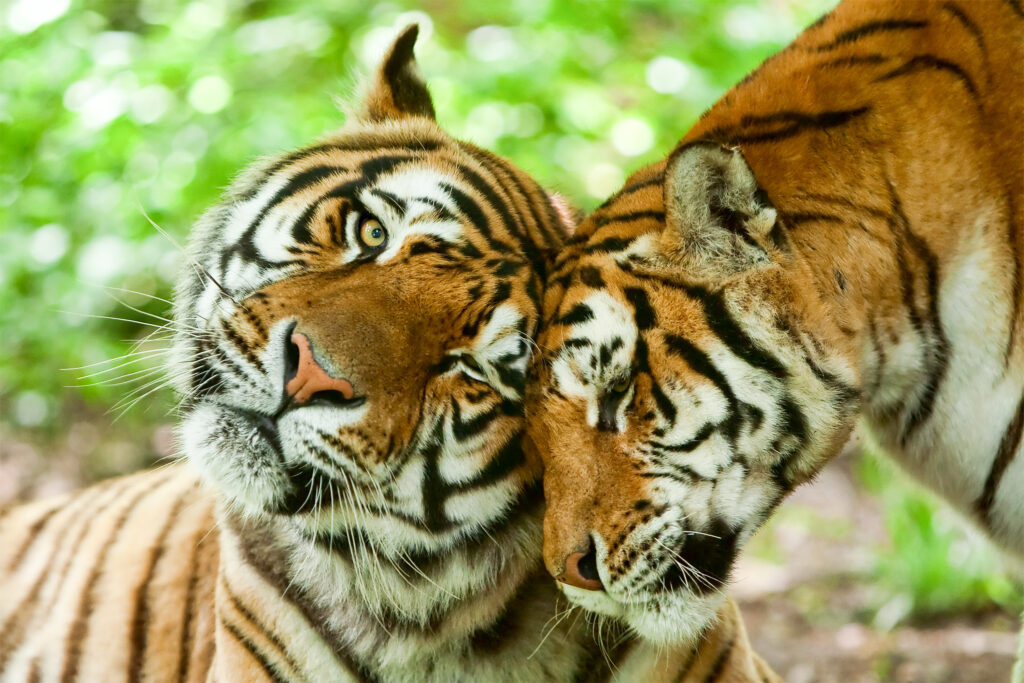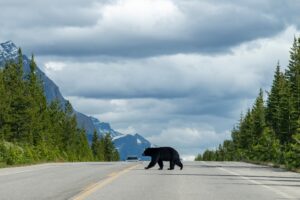
Many remarkable long-distance migrations of wildlife occur around the world every year to ensure that animals arrive at the right place at the right time for feeding, mating, and birthing. Meanwhile, shorter-distance movements, such as those of black bears, are less epic but no less important in the quest to find suitable mates, food, and den sites. But what happens when love is in the air, but movement becomes difficult due to habitat fragmentation? The short-term effect may be a missed connection, but in the long-term, it could reduce the genetic diversity that helps keep wildlife populations healthy.
Male black bears tend to have mating ranges 10-15 miles in diameter, each containing about a dozen female territories. During mating season, both males and females move around a lot to advertise themselves as being available and to find each other, which requires a lot more space and energy than scrolling on a dating app. All this movement means bears traverse large landscapes, requiring uninterrupted swaths of habitat. Their journeys can be especially dangerous if they get sidetracked by roads or other development and run afoul of human communities. Getting hit by cars or trains is a real threat.
“Animals instinctively disperse from their family groups to search for high-quality mates, and this helps maintain genetic diversity among the species,” says the Center’s Conservation Program Director Dr. Megan Parker. “Gene flow, or the transfer of genes from one group to another, is critical for healthy populations.”
Barriers to movement can lead to isolation, and this genetic isolation, or inbreeding, can diminish reproductive success, increase the risk of birth defects, make species more vulnerable to diseases, and reduce their ability to evolve and adapt to change over time.

Endangered species often experience loss of genetic diversity, as the gene pool shrinks along with the population. But Parker said that reduced gene flow can happen to more numerous species as well.
“Even if relatively abundant in total numbers, some wildlife populations may lose genetic diversity when habitat loss and fragmentation create isolated ‘islands,’ where animals of the same species can’t reach each other,” says Parker. “The gene flow impacts of roads, fences, subdivisions, and other human development may be the same as having a low total population: animals only have a small selection of mates, some of whom may be close relatives.”
Study after study documenting the negative consequences of fragmentation-caused reduced gene flow show these deleterious effects in species ranging from Australian freshwater fish to Mexican spotted owl to roe deer in Switzerland. That’s why ecological corridors—or connections between natural areas—are so important.
Looking for Love
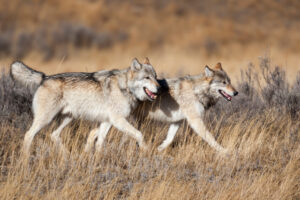
Bull moose and elk have been known to go on extended walkabouts during mating season in search of female companionship. On the other end of the size spectrum, the smallmouth mole salamander, which lives in the U.S., will travel up to nine miles—pretty impressive for a 7-inch amphibian with stubby legs—to reach new breeding ground and find a mate that’s probably not their first cousin.
We see this behavior in all kinds of species, and large carnivores may go especially long distances. But why the long trips? We have all heard the term “lone wolf,” and it has its basis in a natural occurrence: when a wolf decides it is time to leave its pack and strike out alone. Otherwise known as dispersing, this is how male and female wolves find mates and form new packs, naturally fostering genetic diversity.
Similar to wolves, male tigers “migrate” away from areas densely populated with other tigers in order to stake out a new territory without another dominant male and with at least one suitable mate. A collared tiger known as T1-C1, aka “Walker,” was tracked on an epic 800-mile journey over five months in 2019 to find a new home.
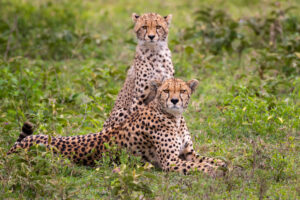 “With Asia experiencing unprecedented levels of development, this process is increasingly difficult yet critically important,” warns Parker. “Scientists believe that lack of genetic diversity is contributing to the population declines of several big cat species, including tigers.”
“With Asia experiencing unprecedented levels of development, this process is increasingly difficult yet critically important,” warns Parker. “Scientists believe that lack of genetic diversity is contributing to the population declines of several big cat species, including tigers.”
Cheetahs, which already had very low genetic diversity due to a population “bottleneck” that occurred when they almost went extinct around 10,000 years ago, have lost even more genetic variation due to habitat loss and fragmentation in Africa.
“While cheetahs are not listed as endangered,” explains Parker, “they are considered vulnerable as their numbers gradually decline amid habitat loss and fragmentation that makes it difficult to find suitable mates outside their immediate neighborhood.”
Making a Love Connection
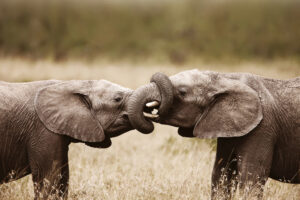 To prevent genetic isolation and protect small and vulnerable populations, important wildlife migration routes and other movement corridors should be identified and conserved. Of course, in addition to missed matches, habitat fragmentation impacts wildlife populations in a number of other ways, including the inability to access food and water, and an increase in human-wildlife conflict—including wildlife-vehicle collisions.
To prevent genetic isolation and protect small and vulnerable populations, important wildlife migration routes and other movement corridors should be identified and conserved. Of course, in addition to missed matches, habitat fragmentation impacts wildlife populations in a number of other ways, including the inability to access food and water, and an increase in human-wildlife conflict—including wildlife-vehicle collisions.
But what if these corridors have already been blocked? In the case of roads and railways that bisect critical habitat, wildlife crossings—underpasses and overpasses—may be key to restoring connectivity while improving safety for people and animals alike.
Today, many governments and their partners are stepping up to build these structures and explore other suitable mitigation measures. For instance, In Kenya, where 70% of the wild animals live outside protected areas, highway underpasses are being built to reconnect landscapes and reunite elephant groups. In 2011, Africa’s first dedicated elephant underpass restored the link between 2,000 elephants on Mt. Kenya with 5,000 more below. Since then, Kenya has constructed several more underpasses for elephants to pass under roads and railways, helping to keep them safe from collisions while facilitating their search for food as well as mates.
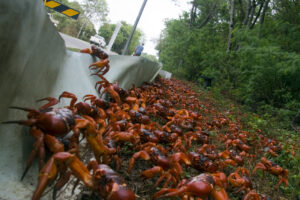 Even some of the smaller critters have fan bases working on solutions for safe passage, such as salamanders in Vermont, tortoises in the southwest U.S., and even red crabs in Australia. Each year, millions of red crabs on Christmas Island emerge from the forest and make their way to the ocean to breed. To protect their beloved local crustacean, the government sometimes closes sections of roads for the day during the mass migration and has built several overpasses for crabs to cross over roads safely.
Even some of the smaller critters have fan bases working on solutions for safe passage, such as salamanders in Vermont, tortoises in the southwest U.S., and even red crabs in Australia. Each year, millions of red crabs on Christmas Island emerge from the forest and make their way to the ocean to breed. To protect their beloved local crustacean, the government sometimes closes sections of roads for the day during the mass migration and has built several overpasses for crabs to cross over roads safely.
Properly designed wildlife crossings with accompanying fencing, which funnel animals toward them, have been shown to reduce wildlife-vehicle collisions by up to 90%. Importantly, Parker says, these structures are also successfully reconnecting habitat where it had been severed and reducing barriers to gene flow.
“When it comes to finding a mate, producing healthy offspring and populations, wildlife corridors—including the human-built ones—are helping facilitate nature’s matchmaking process.”
The Center for Large Landscape Conservation is a leader in connectivity conservation—a large-landscape approach that reaches across political boundaries to collaboratively restore the natural connections between habitat areas. Connected landscapes host healthier wildlife and more resilient communities.
Learn about how we are reconnecting our natural world through our U.S. Program and International Connectivity Program.
Photos, top to bottom: Tigers – Adobe Stock; Black bear – Adobe Stock; Roe deer – Adobe Stock; Wolves in Yellowstone – Adobe Stock; Cheetahs – Adobe Stock; African elephants – Adobe Stock; Red Crab Migration – Frogtail Images, Creative Commons license Cc By Nc Nd 2.0 Deed.
